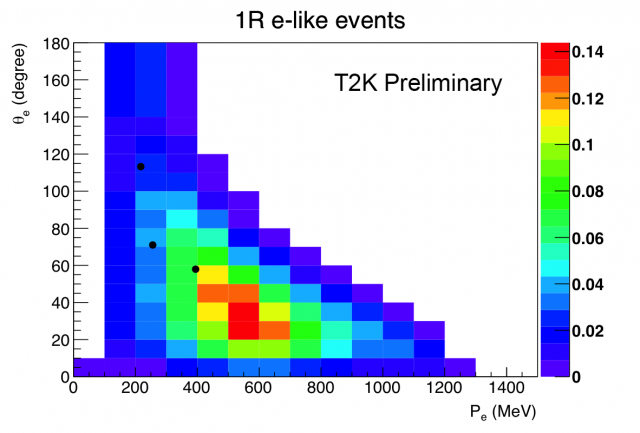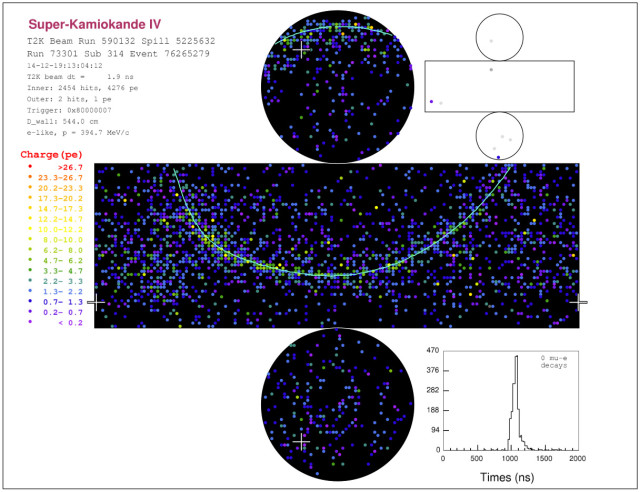T2K observes three candidate electron antineutrino events at Super-Kamiokande in the muon antineutrino beam from J-PARC
The predominance of matter over antimatter in the universe points directly to the existence of some currently hidden laws of physics which are different for matter and anti-matter. One focus of the search for these new laws is the recently-discovered phenomenon of neutrino oscillations. Searching for these new laws of physics will require comparing the oscillations of neutrinos and anti-neutrinos.
The T2K collaboration has observed three electron antineutrino candidate events in a muon antineutrino beam. This is the first antineutrino appearance search by the collaboration, which also observed muon antineutrino disappearance earlier this year. The appearance and disappearance of neutrino and antineutrino flavours is called neutrino oscillation and occurs because of the quantum mechanical interference of neutrino masses and flavours.
T2K began collecting data in antineutrino mode in May 2014, and completed its first run in antineutrino mode in June 2015, collecting 10% of their expected antineutrino data set. Before this run, T2K took data in neutrino mode, 2010 — 2013, and definitively established electron neutrino appearance from a muon neutrino beam. Based on the neutrino mode results, T2K would expect to observe 3.8 events, with 1.8 coming from backgrounds. Although three events is too small to draw firm conclusions, it is a first for T2K with antineutrinos.

Distribution of the three electron antineutrino event candidates, shown against the observed electron angle and momentum. The black dots represent the three data events, and the coloured background represents the expectation based on the neutrino mode result.
These events are a clear demonstration of the potential of the T2K experiment to perform a powerful antineutrino oscillation search. T2K will run in antineutrino mode again in the autumn and should collect more than twice the data already in hand, which could give enough data to make a significant observation.
The search for electron antineutrino appearance is the next step in the exploration of charge-parity (CP) symmetry, which stipulates that antimatter should behave just like matter if viewed through a mirror and upside down. CP violation in neutrinos would manifest itself as antineutrinos oscillating differently than neutrinos, and if this happens it is a strong clue as to the origins of the matter/antimatter imbalance in the Universe today.
T2K’s neutrino mode results gave a first hint that CP might be violated by neutrinos. If that is the case, then the electron antineutrino appearance rates will be suppressed. The current level of statistics are not high enough to be sure. For that, T2K will need to continue running long enough to accumulate sufficient data for a large signal.
Concurrent with the release of the electron antineutrino appearance result, T2K has also updated its observation of muon antineutrino disappearance. In this analysis, the collaboration expects to observe 103.6 events passing the muon antineutrino selection requirements, but instead observed just 34. This clear signature of antineutrino disappearance strengthens the collaboration’s already world-best measurement of the antineutrino mixing angle.
The result was announced in a talk given by Dr Melody Ravonel Salzgeber (University of Geneva) at the European Physical Society Conference on High Energy Physics (EPS-HEP 2015) in Vienna on July 23, and was followed by seminars at KEK/J-PARC in Japan by Dr Hidekazu Tanaka (ICRR) and Fermilab in the USA by Prof Kendall Mahn (Michigan State University).
This result is due to the work of the J-PARC Accelerator Division.




